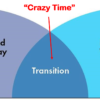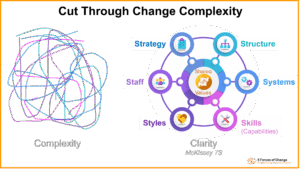
The number one cause of failed change is lack of effective leadership by top management*; a statistic seems that counter-intuitive. Surely executives and senior managers are the authors of organisational change and so logically would be its greatest supporters? But the evidence suggests otherwise. What is going on and what can be done to turn the situation around?
There are two main reasons why many executives and top managers fail to give change their full and necessary support. Firstly, there is a lack of appreciation of what it means to sponsor change and why their personal, visible, active commitment is so crucial to its success. The second reason is that executives, like everyone else, are susceptible to resisting change.

There is little mystery about why executives might resist organizational change. After all, they are humans like the rest of us, and may, in fact, have more reasons than most to feel threatened by change. They may be strongly invested in the status quo, especially if they have been around long enough to have created it. They may fear loss of power and influence following change or resent a change that was not their idea. All such issues can and should be addressed using principles and tools of effective change management (as set out in The 5 Forces of Change). What is less obvious, and the main subject of this article, is why, even when there is a consensus for change among top management, that many do such a poor job of sponsoring it.
Having grappled with the challenge of influencing executives to sponsor organizational change for over two decades and across a variety of industries I have learned that ignorance is at the root of the problem and enlightenment is the solution. This begs two important further questions; what is that many leaders are ignorant of and how can you get their attention to receive enlightenment?
Some typical areas of ignorance include:
- The fact that change can go spectacularly wrong
- Why people struggle with change and what to do about it
- Why leadership is fundamental to successful change
- What they as leaders must say and do to be effective sponsors of change
- The payback for the time and effort they need to invest in change (see ‘The Change Dividend’)
All of these issues can be addressed through an effective Leading Change Workshop .
This takes care of question one. Question two is about getting the attention of busy, important people who may well believe that they did their bit in setting the strategy, and can simply hand over responsibility for making change happen to their subordinates.
The first challenge in addressing question two is to engage top management when they don’t think they have a problem. How can you even get them together in a room for at least a couple of hours or, preferably, half a day? One tactic that has worked for me is to frame the workshop as an Executive Briefing on why people resist change and how you are going to help their subordinate managers to lead people through it successfully. Whatever your approach, your first task is to get the right people in a room together.

Once you have got top management together, you can explore the reasons why people resist change and the leadership skills required to circumvent them. To do this you need leaders to truly engage in the subject. They must begin to feel the pain of poorly managed change, and become excited and motivated to address the issues. This is best achieved this it to apply the Learning Cycle. As explained in an earlier article, this all about involving people in activities and group discussions that enable people reach their own conclusions about change and the imperative for leaders to take action. At some point in this process the executives will start to ask themselves the crucial question, “What do I need to do to make change work?” Then you can begin to work with them to answer that question for themselves, and before you know it, they will start to create a plan of action for sponsoring change – one that they truly believe in, because it was their idea!
*See Prosci benchmark report ‘Best practices in change management’








